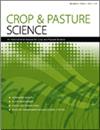豆类选择夏季活跃的牧场在澳大利亚东南部的温带降雨环境
IF 1.9
4区 农林科学
Q2 AGRICULTURE, MULTIDISCIPLINARY
引用次数: 2
摘要
摘要上下文。优质的夏季活跃牧场可以通过促进夏季牲畜的饲养来提高澳大利亚东南部的肉类产量,其中豆类对提高牧场混合物的营养价值至关重要。可用的豆类在抵御水分胁迫和放牧的能力上各不相同。目标。我们的目标是确定适合夏秋整饰系统的豆类。方法。我们在新南威尔士州古尔本和邦巴拉的重复小区试验中测试了8种豆类植物的12个品种的纯草皮,评估了2-3年的生产力、持久性和暖季营养特征。关键成果。苜蓿(Medicago sativa)显然是夏季生产力最高的物种,在这两个地点的大部分实验期间,除了2021年秋季3月的高降雨量外,在持久性和生产力方面都优于三叶草(Trifolium spp.)。高加索三叶草(T.ambiguum)在这两个地点也高度持久。Talish三叶草(T.tumens)和草莓三叶草(T.fragiferum)比白三叶草(T.repens)和红三叶草(T.pratense)更持久。白三叶草在干旱后的高降雨量下恢复得很好,而红三叶草建立得很快,但在干旱后恢复的能力较弱。高加索×白三叶草是产量最低的豆科植物。替代三叶草物种的营养特征值有时略低于白三叶草;红三叶有时具有明显较低的值。结论。卢塞恩表现最好,但在夏秋季节,几种丁香也富有生产力、持久性和高营养价值。含义。Talish、高加索和草莓丁香值得进一步调查,以纳入澳大利亚东南部夏季活跃的牧场。本文章由计算机程序翻译,如有差异,请以英文原文为准。
Legume options for summer-active pastures in a temperate rainfall environment of south-eastern Australia
ABSTRACT Context. High-quality, summer-active pastures could improve meat production in south-eastern Australia by facilitating livestock finishing over summer, with legumes critical for enhancing the nutritive value of pasture mixes. Available legumes vary in their ability to withstand moisture stress and grazing. Aims. We aimed to identify legumes suitable for a summer–autumn finishing system. Methods. We tested pure swards of 12 cultivars across eight legume species in replicated small-plot experiments at Goulburn and Bombala, New South Wales, assessing productivity, persistence and warm-season nutritive characteristics over 2–3 years. Key results. Lucerne (Medicago sativa) was clearly the most productive species during summer and outperformed the clovers (Trifolium spp.) in terms of persistence and productivity throughout most of the experimental period at both sites, except during autumn 2021 after high rainfall in March. Caucasian clover (T. ambiguum) was also highly persistent at both sites. Talish clover (T. tumens) and strawberry clover (T. fragiferum) were more persistent than white clover (T. repens) and red clover (T. pratense). White clover recovered strongly under high rainfall after drought, whereas red clover established rapidly but showed less capacity for post-drought recovery. Hybrid Caucasian × white clover was the least productive legume. Alternative clover species sometimes had slightly lower values of nutritive characteristics than white clover; red clover sometimes had distinctly lower values. Conclusions. Lucerne performed best but several clovers were also productive, persistent and of high nutritive value over the summer–autumn period. Implications. Talish, Caucasian and strawberry clovers warrant further investigation for inclusion in summer-active pastures in south-eastern Australia.
求助全文
通过发布文献求助,成功后即可免费获取论文全文。
去求助
来源期刊

Crop & Pasture Science
AGRICULTURE, MULTIDISCIPLINARY-
CiteScore
4.20
自引率
15.80%
发文量
111
审稿时长
3 months
期刊介绍:
Crop and Pasture Science (formerly known as Australian Journal of Agricultural Research) is an international journal publishing outcomes of strategic research in crop and pasture sciences and the sustainability of farming systems. The primary focus is broad-scale cereals, grain legumes, oilseeds and pastures. Articles are encouraged that advance understanding in plant-based agricultural systems through the use of well-defined and original aims designed to test a hypothesis, innovative and rigorous experimental design, and strong interpretation. The journal embraces experimental approaches from molecular level to whole systems, and the research must present novel findings and progress the science of agriculture.
Crop and Pasture Science is read by agricultural scientists and plant biologists, industry, administrators, policy-makers, and others with an interest in the challenges and opportunities facing world agricultural production.
Crop and Pasture Science is published with the endorsement of the Commonwealth Scientific and Industrial Research Organisation (CSIRO) and the Australian Academy of Science.
 求助内容:
求助内容: 应助结果提醒方式:
应助结果提醒方式:


